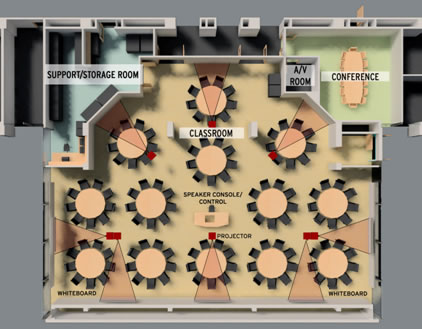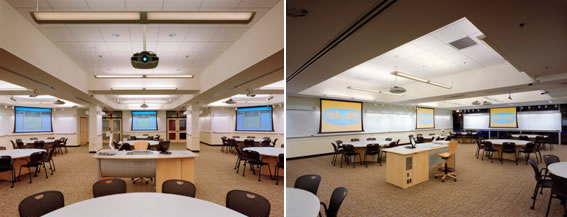© 2005 Phillip D. Long
EDUCAUSE Review, vol. 40, no. 4 (July/August 2005): 60.
Introductory science courses need to merge lectures, recitations, and hands-on laboratory experience into a technologically and collaboratively rich experience for incoming freshmen. This mix of technology, pedagogy, and classroom design results in better learning. Technology Enabled Active Learning (TEAL) at MIT (http://icampus.mit.edu/teal) is the latest iteration of this effective strategy. TEAL is a project of MIT iCampus (supported by Microsoft Research), the d’Arbeloff Fund for Excellence, and the National Science Foundation.
The transition to such a different mode for teaching introductory physics was motivated by
- the low attendance rates that characteristically plague such courses (at MIT, attendance rates were frequently 40% to 50%);
- failure rates averaging 10% or greater;
- recent data showing that pedagogy using "interactive engagement" methods results in higher learning gains than does the traditional lecture format and is usually accompanied by lower failure rates; and
- the reintroduction of the lab experience (for the past thirty years, freshman physics at MIT did not have a laboratory component at all).
MIT is not the first to try this format. "Studio Physics" loosely denotes a format instituted in 1994 at Rennesaeler Polytechnic Institute by Jack Wilson. This pedagogy has been modified and elaborated on by a number of other projects, for example, North Carolina State University’s SCALE-UP Project (http://www.ncsu.edu/PER/scaleup.html), the multi-institutional Activity-Based Physics project (http://physics.dickinson.edu/~abp_web/abp_homepage.html), and the Physics Education Group at the University of Washington (http://www.phys.washington.edu/groups/peg/curric.html). MIT has expanded on the work of others by adding a large component centered on active and passive visualizations of electromagnetic phenomena.
Key elements of TEAL include the following:
- Takes place in a dedicated room (the "studio"), in which students sit in groups of nine, divided into teams of three at tables rather than desks; each team has a computer and space to do experiments
- Uses twenty-minute "mini-lectures" interspersed with assessment questions and thought questions
- Asks concept questions, which students discuss and then respond to using an electronic polling system with handheld voting keypads
- Uses active learning through a wide variety of short experiments (often computer-based), visualizations, pencil-and-paper exercises, and discussion questions; the desktop experiments and computer-aided analysis of experimental data give the students direct experience with the basic phenomena
- Assigns student teams based on assessments of physics knowledge by appointing high-, medium-, and low-scoring students to a team, facilitating peer instruction
- Emphasizes small-group learning
- Uses materials and methods derived from physics education research
It is hard to imagine a TEAL class without observing one. For that reason, a streaming video of a TEAL class in mechanics is available on the Web at http://icampus.mit.edu/teal (click on "TEAL in action").

An outline of the TEAL classroom from above

The TEAL classroom from two perspectives
